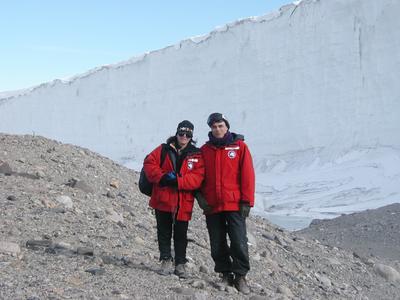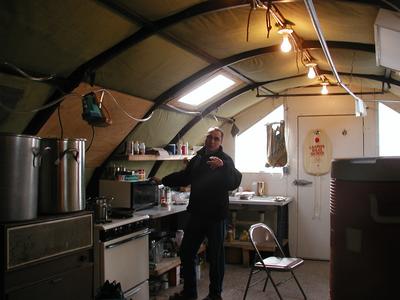
|
|
11 November, 2001
After lunch, I walked to the Commonwealth Glacier with two of our team
members, Dr. Jan Pawlowski and Dr. Sergei Korsun. As we trekked across the
base of the Taylor Dry Valley, the wonderment of Antarctica filled every
step. Today, the weather is incredible! I only needed my wind jacket for
this beautiful five- hour walk. Yesterday, I couldn't get warm enough. The
wind seemed to blow right through the Jamesway. (Actually, the wind was so
strong yesterday, it blew something off the wall.) We left for the glacier
about 1:30 p.m. and made it to the edge of the glacier by 3:00 p.m. The
Taylor Dry Valley is barren, but even so, the variety of rocks and
sediment lend a certain beauty to the surrounding mountains and ice. Many
rocks are sand-blasted or polished from the sediment, wind, and ice. Some
rocks show evidence of cracking or being sliced through by the freeze/wind
conditions here in Antarctica. Walking through the Dry Valley gives the
impression of being on another planet. It is easy to understand why NASA
has chosen to use the Dry Valleys as a model for extraterrestrial studies
for Mars.
As we came upon the glacier, the edge of the glacier seemed to tower above
us. We "skated" along the frozen stream next to the glacier as we listened
to the cracking and moaning of the glacier walls. In order to understand
the science in Antarctica, it is helpful to become familiar with the
make-up of this continent. I've seen glaciers before, but the glaciers in
Antarctica are massive. Life as we know it is more intensified in
Antarctica. The weather, the logistics of getting what we need or where we
need to be, and the constant surprises must always be factored into
everything we do. The batteries in the cameras run down faster in the
cold. To my dismay, the batteries in the digital camera stopped working
before getting the best photos of the glacier. I did get photos with a
35-mm and a digital video camera. One more lesson to learn: Always take
extra charged batteries with the camera and keep them inside an inner layer
of clothes. The view overlooking the glacier gave a broader impression of
the Commonwealth Glacier's slow movement toward the ocean. Glaciers move
slower in Antarctica because it is colder. Many glaciers move several
meters in a year, but the glaciers in Antarctica may take a hundred years
to show the same progress. The parallel sediment lines indicate the
movement of the glacier hundreds and thousands of years ago. The glacier
will lose its mass through ablation: melting and flowing into the
streambed, an iceberg calving (breaking) off from the glacier, or through
evaporation (water changing to a gas).
On the way back to the field camp, an Adelie penguin scurried past us,
destination unknown. We arrived back in camp just in time to cook dinner.
Sergei made steak with gravy, rice, and corn. Dr. Pawlowski worked in his
lab, while Phil Forte, Dr. Bowser, Dr. Pollock, and Rob, the Science Dive
Coordinator (See journal: November 10th) made a collection dive at a hole
near camp. This dive site is near an underwater ice cliff, and is a good
place to collect forams. After dinner, I took a "shower" using warm water
from sea ice melted on the preway stove. A shower bag was hung from the
ceiling, and when finished the "bath" water had to be poured into the
wastewater container. Living in Antarctica takes time. Even the simple
tasks become an ordeal. Yet, without a doubt, the beauty, surprises, and
experiences far out-weigh any of these inconveniences.

Dr. Korsun and I standing near the Commonwealth Glacier.

The Commonwealth Glacier towers over Dr. Korsun and Spike.

Dr. Sergei Korsun putting the ice on the preway stove to melt for wash water.

Tonight was Dr. Korsun's time to cook. We do have a microwave, which is wonderful when we need to defrost meat. The meat is kept frozen in outside coolers. The "shower" seen in the background is hanging up on the door. It will be filled with hot water on the preway stove, then carried and hung in a room with more privacy. All wash water goes into a dishpan -type container to be poured into the waste water barrel after the shower. Even the simple things take time in Antarctica.
Contact the TEA in the field at
.
If you cannot connect through your browser, copy the
TEA's e-mail address in the "To:" line of
your favorite e-mail package.
|
